New Breakthrough in Flexible Composite Materials! Hebei University Research Team Uses Innovative X-ray Scintillators to Develop Three New Materials

X-ray imaging technology has important applications in many fields such as medical diagnosis, defense industry, nuclear technology and radiation safety detection. Scintillator, as the core component in the application of X-ray technology, can convert high-energy X-ray photons into low-energy visible light, thereby realizing X-ray detection and imaging.
At present, most scintillator materials are synthesized by calcination under high temperature conditions, which is not only expensive but also difficult to achieve large-scale preparation on flexible substrates.The development of X-ray scintillator materials that are low in toxicity, highly sensitive to X-rays, and easy to process into flexible matrices has become the focus and difficulty of research in this field.
recently,Associate Professor Zhang Hailei from the School of Chemistry and Professor Yang Yanmin from the School of Physics of Hebei University, together with Professor Richard Hoogenboom from Ghent University, have developed a scintillator with good water dispersibility and high sensitivity to X-rays. They have also developed three materials using water-dispersible scintillators.——Polyurethane foam materials with radioluminescent properties, flexible hydrogel scintillator screens for X-ray imaging, and composite hydrogels for multi-level anti-counterfeiting information encryption. Related results were published in Nature Communications.

Paper link:
https://www.nature.com/articles/s41467-024-46287-8
Follow the official account and reply "scintillator" to download the full paper
Synthesis of Water-Dispersible X-Ray Scintillators
The goal of this research is to develop a water-dispersible X-ray scintillator.The scintillator is based on halloysite nanotubes (HNTs) modified with lead-free X-ray scintillator nanoparticles. HNTs are natural nanomaterials with large cavities, low density, good dispersibility in water, and stable negative charges on the outer surface that prevent nanotube aggregation. At the same time, HNTs also have attractive properties such as good biocompatibility, low toxicity, high stability, hydrophilicity, processability and low cost, making them ideal candidates for making composite materials.
In order to generate nanocrystalline Na5Lu9F32:Tb3+, citric acid (CA) is needed as a chelating agent. In this study, CA was coupled to the outer surface of HNTs-NH2 (amino groups of HNTs), and the obtained citric acid-modified halloysite nanotubes (HNTs-CA) were thoroughly washed to ensure that there was no free CA, which is an important prerequisite for the generation of X-ray scintillators on the surface of nanotubes.The study found that HNTs-CA has good dispersibility in water.
After confirming that HNTs-CA was successfully prepared,The hydrothermal reactor was used to grow X-ray scintillator nanoparticles as a template, and HNTs@Na5Lu9F32:Tb3+.
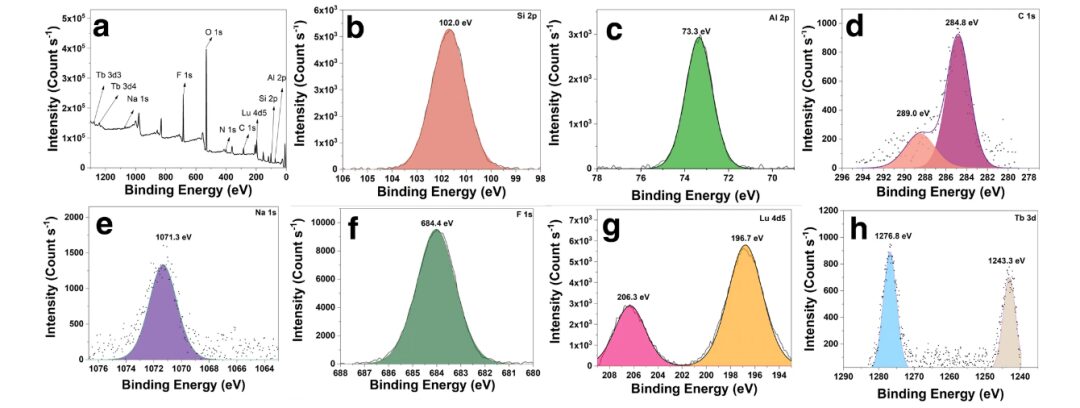
The researchers studied pristine HNTs, HNTs-CA, and HNTs@Na by X-ray irradiation.5Lu9F32:Tb3+ The emission characteristics ofIt was found that their luminescence emission behaviors were completely different.
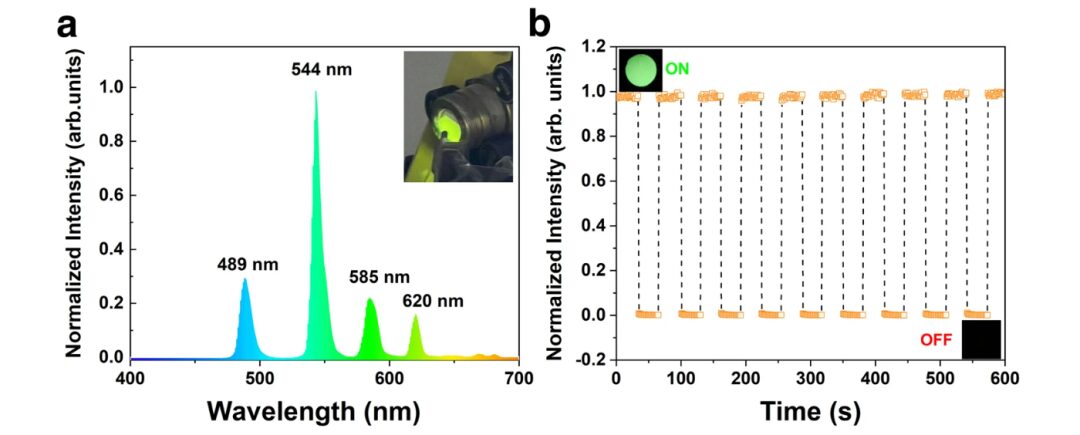
Pristine HNTs and HNTs-CA showed no luminescence properties under X-ray irradiation.
HNTs@Na5Lu9F32:Tb3+ The RL spectrum has four emission peaks at wavelengths of 489, 544, 585 and 620 nm, among which the emission peak intensity at a wavelength of 544 nm is much higher than that of the other emission peaks.Therefore, under X-ray irradiation, HNTs@Na5Lu9F32:Tb3+ Emits strong green fluorescence.
Development and application of new flexible composite materials
X-ray sensitive polyurethane foam (PUF)
Polyurethane foam is a commonly used commercial polymer material widely used in textile, furniture and construction fields. Therefore, if prefabricated polyurethane foam can be functionalized with X-ray scintillators, polymer products with X-ray scintillation properties can be directly obtained.
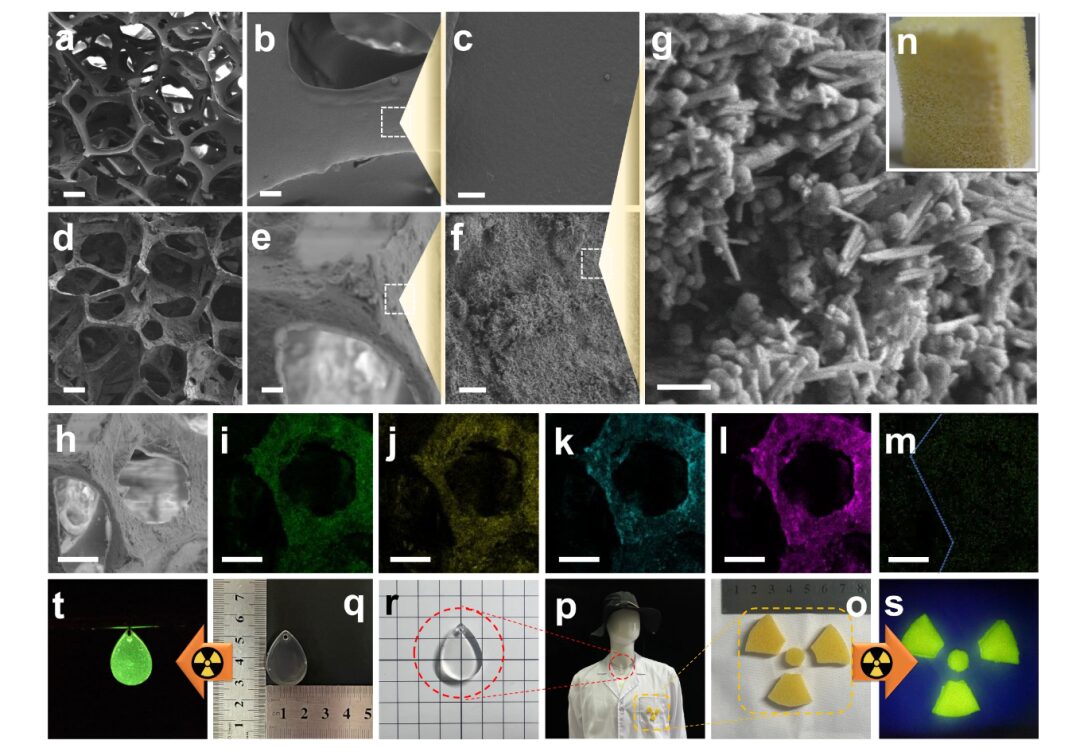
The researchers used scanning electron microscopy to study the original PUF and HNTs@Na5Lu9F32:Tb3+@Microscopic morphology of PUF. PUF shows an open-pore structure with smooth pore walls.
HNTs@Na5Lu9F32:Tb3+The absence of damage to the frame can also be observed in the SEM images of @PUF.The results show that HNTs@Na5Lu9F32:Tb3+ X-ray scintillator adsorption was successful.
To further demonstrate the uniformity of the coating, the researchers randomly selected HNTs@Na5Lu9F32:Tb3+@PUF sample, and recorded the RL spectrum peak intensity at 544 nm wavelength for each point. The relative standard deviation (RSD) value of the results obtained from the intensity value is 4.8%,HNTs@Na5Lu9F32:Tb3+ The coating is uniform on the PUF surface.
Elemental analysis of the cross section showed thatHNTs@Na5Lu9F32:Tb3+ Has good penetration ability. The results of the 30-day stability test showed that HNTs@Na5Lu9F32:Tb3+@PUF has good thermal and photostability.
When exposed to X-rays, HNTs@Na5Lu9F32:Tb3+@PUF can emit visible green light, which is consistent with the emission spectrum of RL excited by X-rays. In addition, the luminescence intensity increases with the X-ray dose from 3.1 to 9.2 cGy s-1 increased with the increase of .
Researchers will HNTs@Na5Lu9F32:Tb3+@PUF samples were cut into the required shapes and pasted onto the white coats; HNTs@Na5Lu9F32:Tb3+ It was added into epoxy resin to make a teardrop-shaped pendant with good transparency, and finally the obtained material was applied in radiation laboratories.
The results showed that both the foam and teardrop-shaped pendants could emit visible green light in response to low-dose X-rays, far lower than those used in brachytherapy.
Flexible hydrogel scintillator screens for X-ray imaging
Thin layer chromatography plates (TLCPs) are commercial materials commonly used in organic chemistry.
Al2O3 It was prepared by mixing with CMC-Na and then coating on a glass slide.
Since the surface of HNTs is mainly composed of Si-O-Si and Al-OH groups, their chemical properties are
Al2O3 Similar to silica gel, this similarity inspired the researchers to obtain HNTs@Na5Lu9F32:Tb3+ Mixed with CMC-Na, solid-state X-ray scintillator screens were developed.
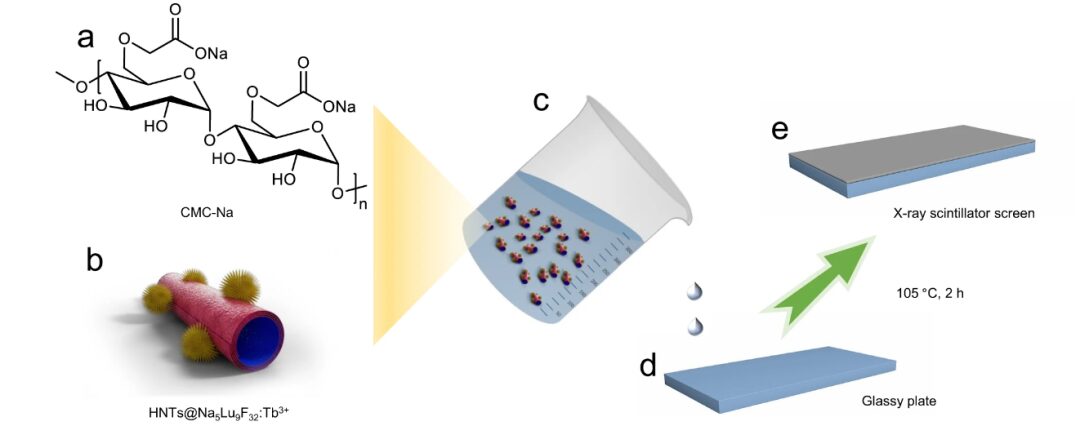
The researchers used a capsule model and homemade imaging equipment to demonstrate the feasibility of X-ray imaging.Stability tests show that HNTs@Na5Lu9F32:Tb3+ The base X-ray scintillation screen has good thermal stability and light stability.
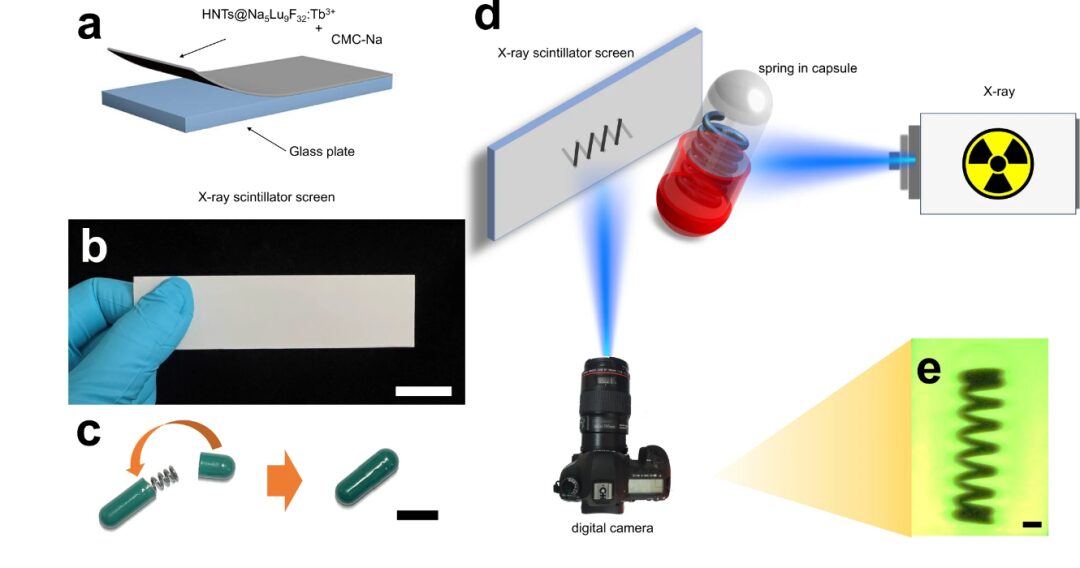
Although similar high-resolution X-ray imaging has been achieved previously at lower X-ray doses using other X-ray scintillators, the lead-free composite X-ray imaging film developed in this study can be prepared by a simpler water-based procedure.This indicates that based on HNTs@Na5Lu9F32:Tb3+ The X-ray imaging screen is scalable.
To overcome the limitations of rigid scintillator screens, the researchers prepared a flexible scintillator screen by incorporating HNTs@Na5Lu9F32:Tb3+ into chemically cross-linked hydrogels. The flexible scintillator screen can adapt to non-flat objects by stretching or bending into desired shapes.
The researchers also tried to modify Na with oleic acid (OA)5Lu9F32:Tb3+ The surface of OA@Na5Lu9F32:Tb3+ The product has improved water dispersibility.5Lu9F32:Tb3+ The hydrogels with OA@Na5Lu9F32:Tb3+ showed better tensile strength than those containing OA@Na5Lu9F32:Tb3+ and even higher than the original hydrogels.Containing HNTs@Na5Lu9F32:Tb3+ The hydrogels should be better than those based on OA@Na5Lu9F32:Tb3+ Its analogs have better application potential in X-ray scintillation screens.
In addition, based on the capsule model,Containing HNTs@Na5Lu9F32:Tb3+ The hydrogel also demonstrated the feasibility of X-ray imaging.Anchoring nanoscintillators on the surface of HNTs can provide new ideas for developing alternative scintillator materials with good mechanical properties.
Composite hydrogel with multi-level anti-counterfeiting information encryption
Hydrogels can change color in response to external stimuli such as UV light, heat, and pH, and have been proposed for storing information. However, information decryption under a single simulation can be easily deciphered, stolen, and forged, which inspired researchers to explore multi-layer encrypted hydrogels based on the different emission behaviors of RL and photoluminescence (PL) stimulated by X-rays. In addition, some organic materials composed of light atoms have weak absorption of X-rays and can only emit light under ultraviolet light, but not under X-ray irradiation. This difference in emission behavior inspired researchers to combine anti-counterfeiting technology and multi-level encryption technology into hybrid hydrogels with encrypted information.
The researchers synthesized three types of hydrogels:* Gel-0 was prepared using 1,4-phenyldiboronic acid as a cross-linker for polyvinyl alcohol (PVA) and was used as a substrate for preparing multilayer hydrogels. It did not emit any fluorescence under UV or X-rays.5Lu9F32:Tb3+ The hydrogel (Gel-1) was prepared using a letter-shaped mold, and boric acid-functionalized tetraphenylethylene (M3) was used to form a three-dimensional network in Gel-1. Gel-2 was prepared similarly to Gel-1, but without the addition of HNTs@Na5Lu9F32:Tb3+, so Gel-2 only has photoluminescence properties
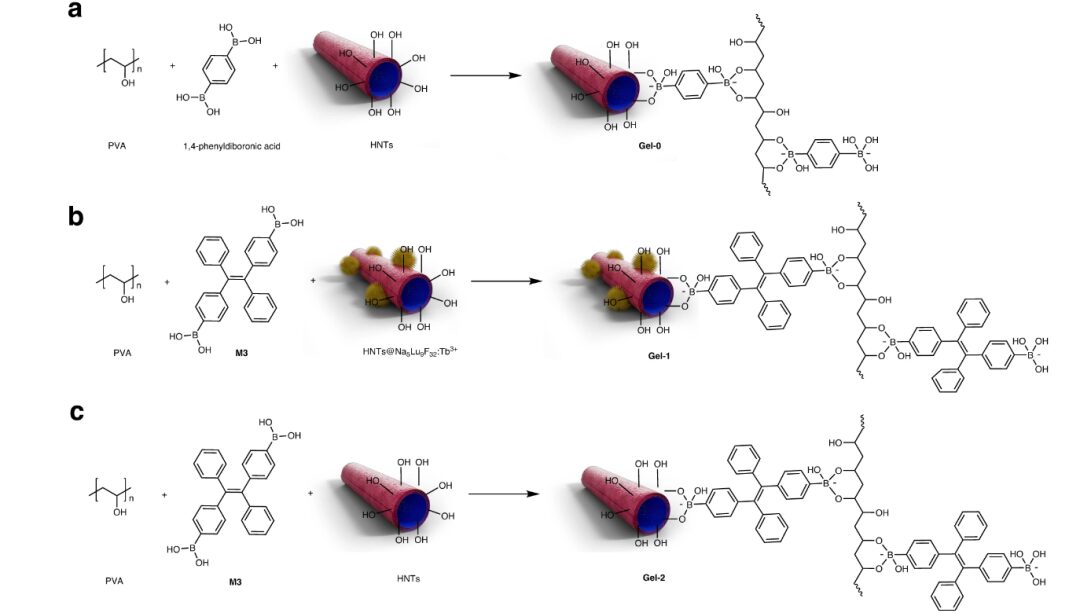
Gel-1 and Gel-2 were prepared in the shape of letters and constituted the information layer. The boronate cross-links and potential arylboronic acid residues in the hydrogels induced self-healing properties and dynamic exchange behaviors, leading to the merging of individual hydrogel layers.This study proposes a design of a sandwich-like multilayer hydrogel with encrypted information.The hydrogel consisted of two outer non-luminescent layers (Gel-0) and an inner information layer (sequence: Gel-0/information layer/Gel-0).
The resulting multilayer hydrogel can be folded or bent into a near-U shape without any shedding between the hydrogel layers, and cannot display any information under normal lighting conditions. Under ultraviolet irradiation, the letters EHBUT glow, which can be clearly observed in the figure below. There is no difference in the luminescence effect of the two luminophores. Information identified from ultraviolet light is considered false information. The encrypted letters (HBU shown in the figure below) can only be identified by X-ray irradiation.
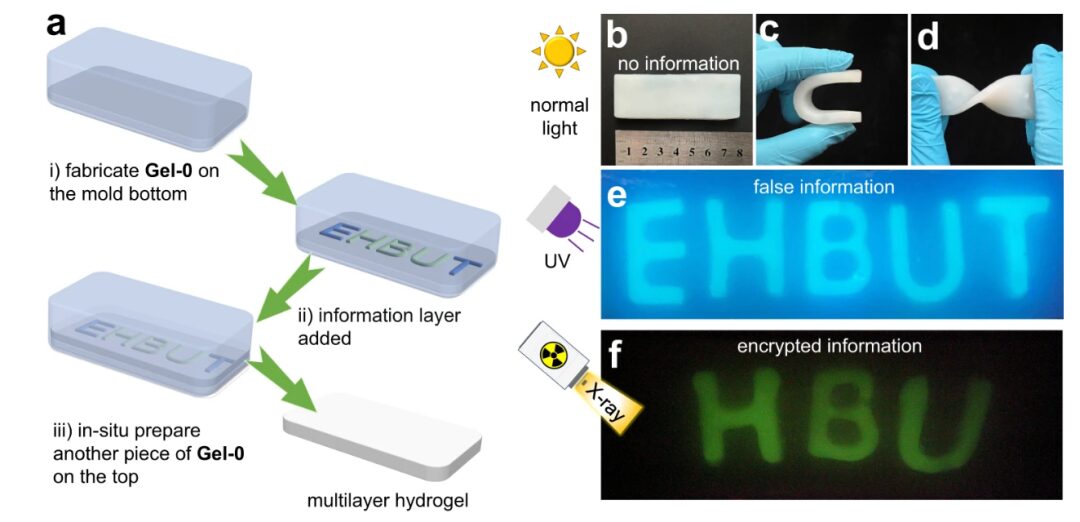
In addition, multilayer hydrogels also support additional security encryption technology to prevent information leakage and combat counterfeit and substandard products. Multilayer hydrogels are connected based on dynamic covalent bonds rather than physical assembly, so the hydrogels are uniform and can be programmed with more complex information camouflage and multi-level encryption according to 3 different types of hydrogel components. In addition, the dynamic covalent bonds present in the obtained multilayer hydrogels also contribute to the realization of potential self-healing properties.
In summary, the research results show thatHNTs@Na5Lu9F32:Tb3+ The nanocrystals are highly efficient X-ray scintillators that can be easily processed as aqueous dispersions.This study also demonstrates the potential of clay-based nanomaterials as supports for functional nanoparticles.This research has successfully expanded the application of X-ray scintillator materials in the field of flexible composite materials, and also provided strong support for the refinement and high value-added development of polymer composite materials.
Develop high-performance, low-cost scintillators to overcome bottleneck problems
After more than a hundred years of development, scintillators have become closely related to people's lives, from nuclear physics research to dental examinations, from Roentgen's discovery of the fluorescence phenomenon of barium platinocyanate to today's high-performance, multi-field applications.
According to the China scintillator industry market research report, the global scintillator market size will reach 4.385 billion yuan in 2022, and the Chinese scintillator market size will reach 479 million yuan. The report predicts that the global scintillator market size will reach 6.985 billion yuan by 2028. Specifically in the medical field, relevant data show that the global medical scintillator market size will be approximately 610 million yuan in 2023, and is expected to reach 850 million yuan in 2030, with a compound annual growth rate of 4.9% during 2024-2030.
However, the core components of high-performance scintillator materials are mostly imported. Chen Qiushui, a "Minjiang Scholar Distinguished Professor" of Fujian Province, a researcher and doctoral supervisor at the School of Chemistry of Fuzhou University, said,"Imported high-end medical imaging equipment and its key components face problems such as high costs and blockade of core technologies. The core manufacturing technology has always been monopolized by Japan and European countries."
In the future, X-ray scintillators will continue to develop in the direction of high performance and low cost. On the one hand, with the continuous advancement of new material technology and the optimization of preparation processes, the performance of X-ray scintillators will be further improved; on the other hand, reducing production costs and improving production efficiency will become an important direction for the development of the X-ray scintillator industry. At the same time, with the continuous innovation of medical imaging technology and security inspection technology and the expansion of application fields, the market demand for X-ray scintillators will continue to grow.
Faced with foreign technological blockades, independent innovation and research and development are the only way out. China urgently needs to develop new X-ray imaging scintillator materials to achieve a breakthrough.